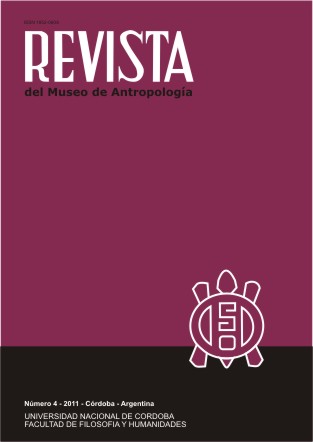School representations about “lo Comechingón” in Córdoba
DOI:
https://doi.org/10.31048/1852.4826.v4.n1.5493Keywords:
indigenous, representation, education, social imaginaries, identificationsAbstract
What imaginaries about the aboriginal are constructed nowadays in Córdoba? This article analyzes the common sense suppositions according to which in the province, especially in the city of Córdoba, the natives are traced back to a more or less distant past. The representations built from the hegemonic social imaginary deny the contemporaneousness of the natives, or at best, they consider its presence as an anomaly; that is to say, they place the aboriginal as a former and outside reality turning it invisible, or giving a relative vision of its contemporary and autochthonous presences in a context of emergency and “comechingon” identification. Thus, said presences become doubted and questioned. These relative presences define a form of aboriginality in which the doubts about the authenticity, from the spatial temporal locus established in the imaginary of Córdoba, question the indigenous identifications. Through the analysis of school texts I look into the pictures, the meanings and senses about the current native presences, which are built, reproduced, established and disputed in the educative sphere of our province.Downloads
References
Beckett, J. (ed) 1988. Past and Present. The construction of Aboriginality. “Introduction”. Canberra. Aboriginal Studies Press.
Briones, C. 1998. La alteridad del “cuarto mundo”. Una deconstrucción antropológica de la diferencia. Buenos Aires. Serie Antropológica Ediciones del Sol.
CIICA Centro de Investigaciones del Instituto de Culturas Aborígenes. 2009. Hijos del Suquía. Los comechingones del Pueblo de la Toma, actual barrio Alberdi, ayer y hoy. Córdoba. Editorial Universidad Nacional de Córdoba.
Escolar, D. 2007. Los dones étnicos de la Nación. Identidades huarpe y modos de producción de soberanía en Argentina. Buenos Aires. Prometeo Libros.
Goody J. 1996. Cultura escrita en sociedades tradicionales. Introducción. Barcelona, Gedisa.
Lanusse, P, A. Lazzari. 2005. “Salteñidad y pueblos indígenas: continuidad y cambios en identidades y moralidades” En: Briones, C. (comp.) Cartografías argentinas: políticas indígenas y formaciones provinciales de alteridad. Buenos Aires. Antropofagia.
Lazzari, A. 2007. Ya no más cuerpos muertos: mediación e interrupción en el reconocimiento ranquel. En: E-misférica Journal of Performance and Politics in the Americas. Hemispheric Institute of Performance & Politics. http://hemisphericinstitute.org/journal
McKenzie, D. 2005. La sociología de un texto: cultura oral, alfabetización e imprenta en los primeros años de Nueva Zelanda. Bibliografía y sociología de los textos. Madrid. Akal.
Novaro, G. 2003. “Indios”, “Aborígenes” y “Pueblos Originarios”. Sobre el cambio de conceptos y la continuidad de las concepciones escolares. En: Educación, lenguaje y sociedad. Vol. 1 N° 1. Diciembre 2003.
Podgorny, I. 1999. Arqueología de la educación. Textos, indicios, monumentos. Buenos Aires. Sociedad Argentina de Antropología. Colección Tesis Doctorales.
Restrepo, E. 2004. Teorías contemporáneas de la etnicidad. Stuart Hall y Michel Foucault. Cauca. Editorial Universidad del Cauca. Colección Jigra de Letras. Rivera Cusicanqui, S. 2010. Violencia e interculturalidad: Paradojas de la etnicidad en la Bolivia de hoy. En: Revista Cultural del Instituto de Culturas Aborígenes Pachamama, Ñuque Mapu, Yvy Pora. N° 23. Córdoba. Imprentica.
Romero, H. 2004. Imaginario y representaciones sociales. Características de las representaciones sociales. Ponencia publicada en CD como trabajo completo en el IV Encuentro Nacional y I Latinoamericano: La Universidad como objeto de investigación realizado en Tucumán en octubre de 2004. En: http://rapes.unsl.edu.ar/Congresos_realizados/Congresos/IV%20Encuentro%20-%20Oct2004/eje8/053.htm
Vasilachis de Gialdino I. 1997. La construcción de representaciones sociales: el discurso político y la prensa escrita, Barcelona. Gedisa.
Downloads
Published
Issue
Section
License
Those authors who have publications with this Journalaccept the following terms:
a. Authors will retain their copyrights and guarantee the journal the right of first publication of their work, which will be simultaneously subject to the Creative Commons Attribution License (Licencia de reconocimiento de Creative Commons) that allows third parties to share the work as long as its author and his first publication in this journal.
b. Authors may adopt other non-exclusive licensing agreements for the distribution of the version of the published work (eg, deposit it in an institutional electronic file or publish it in a monographic volume) provided that the initial publication in this journal is indicated.
c. Authors are allowed and recommended to disseminate their work on the Internet (eg in institutional telematic archives or on their website) before and during the submission process, which can lead to interesting exchanges and increase citations of the published work. (See The Effect of Open Access - El efecto del acceso abierto)












